The Bottled Water Bamboozle / Commodities / Water Sector
 Bottledwater is now the most consumed drink sold in a plastic bottle in the UnitedStates. The fact that North Americans don’t think twice about paying up to $5for a bottle of H2O has allowed Nestle Waters - the largest bottled watercompany in the world - to sell $7.4 billion worth in 2016, and that was just forwater, one of dozens of products from chocolate to baby food marketed by theSwiss food and beverage conglomerate.
Bottledwater is now the most consumed drink sold in a plastic bottle in the UnitedStates. The fact that North Americans don’t think twice about paying up to $5for a bottle of H2O has allowed Nestle Waters - the largest bottled watercompany in the world - to sell $7.4 billion worth in 2016, and that was just forwater, one of dozens of products from chocolate to baby food marketed by theSwiss food and beverage conglomerate.
Perhapsif Canadians and Americans knew what drilling for water, pumping it to thesurface, and piping it to a bottling plant was doing to the world’s groundwatersupplies, not to mention the world’s oceans where a lot of the plastic ends up, they would switch to the tap. Incidentally, tap watercosts Canadians on the order of tenths of a cent per liter.
Thebottled water industry is BIG and growing. Globally, it is estimated to beworth around $170 billion. In Canada the industry generates $2.5 billion inannual sales. In the US, sales reached $16 billion in 2017 - 10% higher than2016.
Nosurprise there. Consider the margin on a bottle of a water. Even when theexpenses to pump, pipe, bottle and distribute it are taken into account, thecost per unit is very low compared to the selling price. Companies pay next tonothing for the water they draw from underground aquifers, if they’re not justusing city water, treating it and passing it off as something exotic.
Thisarticle will take a look at this highly profitable but unethical industry thathas duped literally billions of people into believing that bottled water isbetter for you and worth paying top dollar for. Of course, sometimes bottledwater is necessary where clean tap water is unavailable. We’re exempting thosefolks, since they don’t have a choice in the water they drink. We’ll also do aglobal survey of the state of the world’s aquifers, to show just how much of arisk water boards are taking in allowing multinational companies to depletebillions of gallons/ liters of a scarce fresh water resource. We are trulybeing bamboozled.
Water exploitation
Thetop three bottled water companies are Coca-Cola, Pepsi and Nestle. Coke alsoowns Dasani, a popular brand. There are numerous examples of the big threebeing blamed for water shortages in areas that are already water-stressed. Someof the objections have resulted in court cases with multi-million-dollar damagepayouts.
Cokefor example has been accused of drying up communities and farmers' wells tofeed its bottling plants, thus destroying local agriculture. It takes almostthree liters of water to make one liter of Coca-Cola.
Thecompany’s negative impacts on water have been particularly felt in India - oneof the most water-stressed nations on Earth, according to aNASA satellite study. Backlashes have been organized in several Indian states including Rajasthan, Uttar Pradesh, Kerala and Maharastra.
Inarid Rajasthan, Coke set up a plant in 2000. Official documents from thegovernment’s water ministry show stable water levels between 1995 and 2000, butthe levels dropping 10 meters over the next five years. In the southern stateof Kerala a Coca-Cola bottling plant was shut down in 2004 on grounds that ithad over-used and contaminated local water sources. The state later passedlegislation allowing Coca-Cola to be sued for as much as $47 million.
A similar conflict occurred 10 years later in the city ofVaranasi, Uttar Pradesh, where Coke wasordered to shut down its plant following complaints that it was drawingexcessive amounts of groundwater and it was found to have violated itsoperating license.
In2017 over a million traders boycotted carbonated drinks after claims from two Indian trade associations thatforeign firms were exploiting water resources. Their concerns were brought tolight following low rainfall during the monsoon season, which led to a droughtin Tamil Nadu.
Bottlingsoft drinks is especially problematic in India considering that companies arecompeting with farmers for water and many regions are parched. Not only that,it takes sugarcane to extract sugar to make pop, and sugarcane is verywater-intensive. The director of India Resource Centre, an NGO, told The Guardian ittakes 1.9 liters of water to make a bottle of Coca-Cola. But when combined withthe amount of water used to grow sugarcane, it’s more like 400 liters to makeone liter of Coke.
InEl Salvador the world’s largest beverage maker was accused of exhausting waterover a period of 25 years, and in Mexico, the government led by formerPresident Vicente Fox - a past Coca-Cola president - reportedly gave thecompany concessions to exploit local water resources.
InNorth America, bottled water companies have clashed with local interests inCalifornia, Michigan, Ontario and British Columbia. The measly amounts thesecompanies pay for groundwater is at best unethical, at worst criminal.
TakeMichigan as an example. The water-rich state (surrounded by four Great Lakes)charges water bottlers just $200 in administrative fees a year. How do they getaway with it? It goes back to British common law. The “reasonable use” doctrineallows landowners to use the water on or under their properties so long as itdoesn’t affect neighboring ground or surface waters. The principle underpinningthe doctrine is that nobody “owns” the groundwater. The problem is this leadsto a “tragedy of the commons” situation, where users sharing resources act intheir own interests not the interests of the common good.
Michigan Live reports that this same legal principle is applied not just in Michigan, but most stateseast of the Mississippi. Maine charges $50 per million gallons, Maryland givesit away for free. Only 18 states tax water-bottling factories.
Anine-year court battle against Nestle resulted in a 2009 settlement thatlimited Nestle to pumping just over 200 gallons per minute from its four wellsnear Canadian lakes in Mecosta County, Michigan. The company wanted 400 gpm.
In2017 Nestle got itself into a fight with a Michigan township over its plan to pump 794 millions of liters ofgroundwater annually (1,500 liters a minute) for bottled use.
Californiansare also unimpressed with the Swiss food and beverage titan. Despiteexperiencing the worst drought since the 1400s, Nestle took advantage of therebeing no laws on the books in California to draw water from multiple Indian reserves, California currently has 108 bottled water plants.
Tobottle its Arrowhead brand using water from Strawberry Creek in the SanBernadino National Forest, Nestle pays the forest service $524 a year; thewater rights cost nothing due to a 19th century possessory claim, according toa feature article in Los Angeles Magazine. In 2015 Nestle’s 12 wells pulled 36 million gallons fromStrawberry Creek. Activists filed a lawsuit. The suit was recently resolved,with Nestle being granted a three-year water extraction permit, albeit withrestrictions that will keep a creek flowing for other uses.
InCanada Nestle has clashed with activists in southern Ontario, near Guelph. Nestle Waters Canada has a permit to take up to 3.6million liters a day from its well at Aberfoyle but in 2015 opponents urged theprovince not to renew its license. They claimed the extraction wasn’t sustainable,given that the area was in a drought, and also noticed the aquifer had dropped1.5 meters between 2011 and 2015 when Nestle had increased its pumping rate bya third.
The Ontario government has come under fire for setting itsrates too low for commercial groundwater extraction. The rate used to be$3.71 per million liters (yes you read that right) but in 2017 it went up to$503.71. Water bottlers got a pass until the new rate came into effect, withOntario allowing them to pump 7.6 million liters a day on expired permits, “asit gives them time to amend renewal applications,” CBC reported.
Ifyou think that’s bad, in British Columbia, the former Liberal government wasthrown down a well by the public in 2015 - a drought year also in BC - forgiving away water to Nestle for far too cheap. Premier Clark ordered a review of water rates charged after 200,000 people signed a petition complainingabout Nestle being allowed to bottle 265 million liters of BC water for - waitfor it - $596.25 a year.
Going upmarket
Incase you haven’t noticed when you grab a bottle of water at the airport foryour flight, the choices have greatly expanded, along with prices. Coke andPepsi are reportedly bottling higher-end water to compete with industry stalwarts like Evian andPerrier, and introducing fizzy and fruit varieties. Two such brands, Lifewatrand Smartwater, sell for $2.79 per one-liter bottle at 7-Eleven in New York,compared to $1.50 for 7-Eleven’s brand of the same size.
Theever-expanding Chinese middle class is a popular target market for these more expensive bottles. Coke reportedly launched a Swiss brand of sparklingwater that is double the cost of a Starbucks venti (extra large) cappuccino.Its Valser water, also said to be sourced in Switzerland, apparently costsUS$9.29 a bottle.
Premier brands are also being launched in India, where they are seen as a status symbol, includingCoke’s ultra-elitist-sounding Glaceau Smartwater.
Justfor fun, take a look at the 10 most expensive bottled waters in the world, ranging from $5 per 750-ml bottle, to an outrageous$60,000 for Acqua di Cristallo Tributo a Modigliani, which comes in a 24-karatgold vessel.
“Bottled water is almost 2,000 times moreenergy intensive to produce than tap water A research study from 2009 suggests that producing bottled water requires between 5.6 and 10.2million joules of energy per liter, depending on transportation factors (atypical personal-sized water bottle is about 0.5 liters). That’s up to 2,000times the energy required to produce tap water, which costs about 0.005 millionjoules per liter for treatment and distribution. The same research paperestimates that 50 million barrels of oil are dumped into the creation of ayear's worth of plastic water bottles (a number that has probably gone up sincethe research was conducted). Another sources estimates that the amount of oilused to make a year's worth of bottles could fill onemillion carsfor a year.” WaterDocs,10 outrageous facts about bottled water we need totake seriously
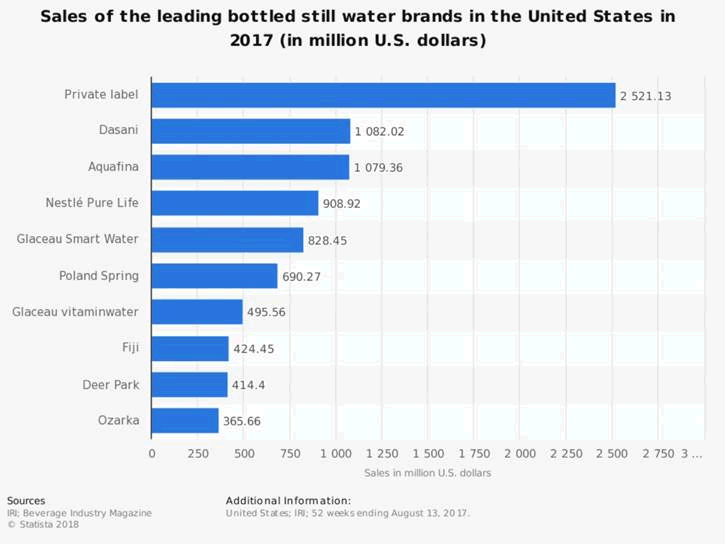
Not so pure
If the quality of bottled water was so much better than tapwater, there would be some justification for paying a premium for it. But alittle research shows this isn’t the case. Unlike publicly supplied water,which is subject to regular scrutiny, bottled water is not subject to the sameguidelines. In fact bottled water in Canada is classified the same as foodwhich is governed by the Food and Drugs Act, meaning it only needs not tocontain “poisonous or harmful substances.”
The bottled water industry is estimated to be worth nearly$200 billion a year, surpassing sugary sodas as the most popular beverage in manycountries. But its perceived image of cleanliness and purity is beingchallenged by a global investigation that found the water tested isoften contaminated with tiny particles of plastic.
"Our love affair with making single-use disposable plasticsout of a material that lasts for literally centuries — that's a disconnect, andI think we need to rethink our relationship with that," says Prof. SherriMason, a microplastics researcher who carried out the laboratory work at theState University of New York (SUNY). CBC.com
Studies suggest disposable, plastic water bottles can harbor hundreds of tiny bitsof plastic, and we're drinking them down with bottled H2O
Between 2000 and 2009 there were 29 recalls of bottled waterproducts due to contaminants, which included bacteria, mould, arsenic andglass. People are taking more of a risk drinking bottled water than tap water.
And what of those delicious-sounding adjectives, like “springwater”, “artesian water”, “glacier-fed” etc.? According to CBC,unless the water is labelled spring water or mineral water, the companies don’thave to reveal its source. In the US, an estimated 45% of bottled water isactually tap water that has been treated with additives. A class action lawsuitagainst Nestle, which labeled its Poland Spring water as “naturally purifiedspring water” when in fact it was from groundwater, was settled out of court,with the multinational agreeing to pay $10 million.
In 2004 Coca-Cola was scandalized when the UKlaunch of its Dasani brand was tarnished by a reporter’s finding that Dasani was in fact upgraded tap water. Makingmatters worse, a bad batch of minerals contaminated production, and Coke wasforced to pull all half a million bottles in circulation off shelves.
How much water do wehave?
The bottled water companies would like you to believe that whilethe amount of underground water (and tap water) they are using soundsegregious, it is in fact small compared to the water used for irrigation andother purposes, in the country they are operating in.
The problem with this argument is that the planet’s fresh water is- contrary to popular notions - extremely limited. We have written on thisseveral times before, but here are the facts again, this time from the US Geological Survey (USGS). The photo of the globe below with the blue circles makesit easy to visualize.
All the water on Earth makes up 1.386 billion cubic kilometers.Almost all of it, 96.5%, is seawater.
More than 2 billion people lack safe drinking water. That number will only grow
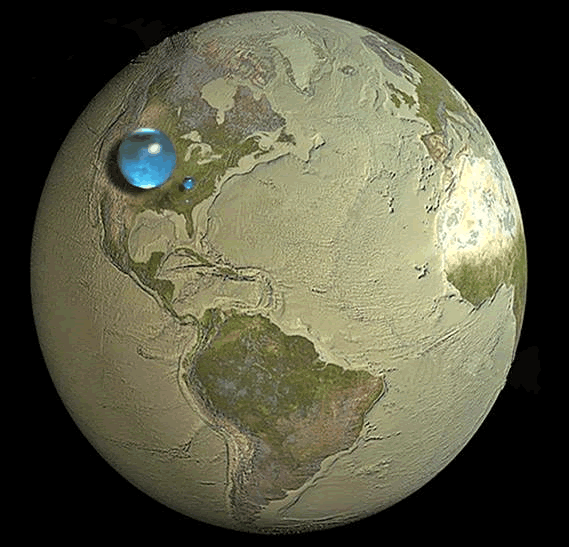
The large blue sphere on the map represents not just seawater butwater locked in ice caps, glaciers, lakes, rivers, groundwater, in theatmosphere, in soil, and even in living beings.
Now look at the blue sphere over Kentucky. This represents all theworld’s fresh water. It is 10.633 million cubic kilometers, or 3.46% of theplanet’s total water.
But much of this water is unusable - swamp water, soil moisture,saline groundwater/ lakes, or locked up in ice caps, glaciers, ground ice andpermafrost. This leaves just 0.78% of usable water; of this, fresh groundwatermakes up 0.76%. Put another way, of all the water on Earth, less than 1% isstored underground, and this precious water is being tapped furiously bybottled water companies and oil and gas companies who use it for fracking.
Eachfracking well uses between 1.5 and 15 million gallons of fresh water. This iswater that could be used for drinking, by animals or humans, or for irrigatingcrops and pastures. Billions of gallons of fresh water are destroyed in theprocess of mixing water with chemicals and frack sand to break apart layers ofshale rock to extract oil and gas.
Thirtyto 40% of the fracking fluid is left in the well. The “flowback liquid” that isleft after the gas is extracted contains water and a number of contaminants,including radioactive material (like radium, which can cause leukemia), heavymetals, hydrocarbons, bromide and other toxins.
Thewastewater pumped underground goes into oil and gas waste wells or salineaquifers. There are serious concerns about the ability of these caverns andaquifers to handle the increased pressure and the evidence is showing thatdeep-well injecting is linked to the occurrence of earthquakes.
Formore read our The real price of LNG
As for what most of the world’s fresh water is used for, it’s mostlyto generate power, at least in the United States and Canada. In Canada 34.7 billion cubicmeters are used for power generation, mining and manufacturing, farm irrigationuses 1.7 billion cubic meters, and households use 3.2 billion.

How much groundwater isleft?
It may not seem like it living in a place like British Columbia(as I write this the rainfall is biblical) but we are in the midst of a seriousfresh water crisis.
Since 99% of Earth’s fresh water is groundwater, this is the mostimportant source to look at in terms of depletion.
There are two types of aquifers: the shallow kind that getrecharged from surface water, and deeper aquifers that contain ancient waterthat has been locked under the Earth for centuries. Once these non-rechargeableaquifers are gone, they’re gone for good. A University of Victoria study found that just 6% of global groundwater is beingreplenished within 50 years.
According to the Stockholm International Water Institute (SIWI),we could be looking at a 40% shortfall in the availability of water within just12 years - that includes the 600 aquifers that cross borders; at currentusages, there are sure to be more fights over water in future.
This is happening already. According to the Pacific Institute’s Water Conflict Chronology, in 2017 there were over 70 conflicts over water, comparedto just three in 1997. Examples include 70 people killed in Darfur in a clashbetween farmers and herders; and threats by bandits in India to kill people ifthey weren’t brought water during a drought.
Of the world’s population of 7.6 billion, 2 billion rely ongroundwater. SIWI states that total groundwater withdrawals already exceedavailability in about 20% of the world’s aquifers, which provide 35% of theplanet’s fresh water.
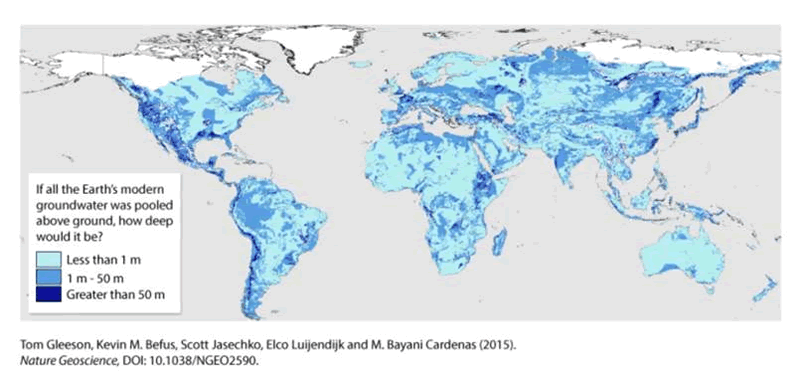
It gets worse. As aquifers are depleting, demand for water isgrowing. It’s expected to increase 55% by 2050 - mostly due to the need for more food production. Demand increases duringdroughts, when surface water gets dried up first. California for example, in adrought since 2011, currently taps aquifers for 60% of its water, 20% more thannormal.
Sohow are the world’s aquifers doing, region by region? NASA attempted to answer this question using satellite data. It found that of the major graveland sand-filled aquifers, 21 out of 37 (56%) are receding. A third weredescribed as “highly stressed,” “extremely stressed” or “overstressed”. SIWIstates that nearly half of the world’s aquifers may be past their tippingpoint, meaning a natural recovery has become impossible.
“Thewater table is dropping all over the world. There’s not an infinite supply ofwater,” says Jay Famiglietti, senior water scientist at NASA. Falling watertables also lead to increased electricity costs to pump the water up fromdeeper down.
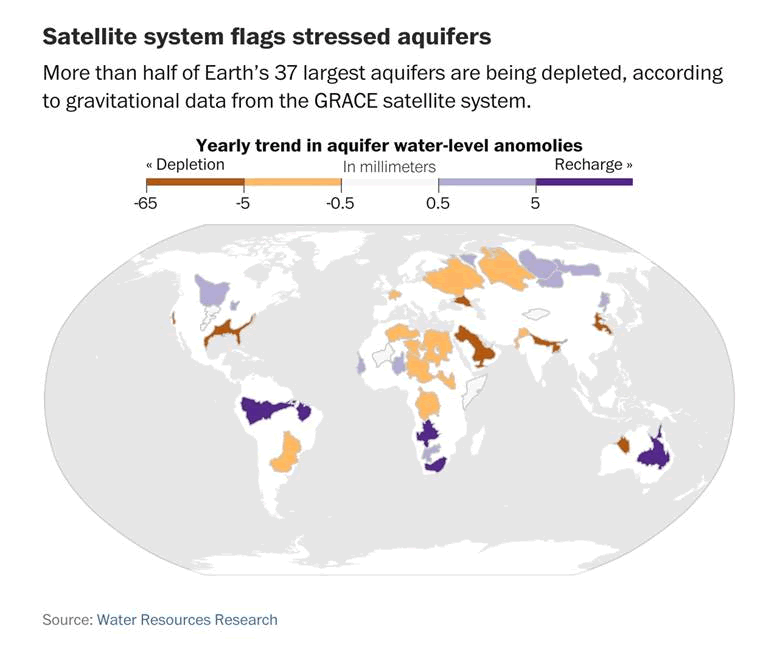
Themost water-stressed aquifers, according to the NASA study and a very recent survey by the SIWI, are:
Arabian Aquifer, used by over 60 million people across the ArabianPeninsula; 90% of the groundwater is pumped for agriculture. Indus Basin in India and Pakistan. Home to 300 million people, theIndus Basin has seen the water table in some parts drop as much as 20 feet. Ganges-Brahmaputra Basin, encompassing India, China, Nepal,Bangladesh and Bhutan, holds 10% of the world’s population.Murzuk-Djado Basin in northern Africa.Northwest Saharan Aquifer, flowing under 60% of Algeria, almost athird of Libya and part of Tunisia.Nubian Aquifer System, also in northern Africa, is the largestnon-rechargeable aquifer in the world. It spans Egypt, Libya, Sudan and Chad. Canning Basin, Australia. North China Plain Aquifer, where about 11% of the Chinesepopulation lives, including the capital Beijing. Central Valley Aquifer, California - the most troubled aquifer inthe United States. The current drought is forcing farmers to drill wells intothe aquifer for irrigation. The Central Valley Aquifer irrigates 25% of allfood produced in America. Atlantic and Gulf Coastal Plains Aquifer, along the southeast UScoast and Florida.
The red area on the above map (click on map to biggie size) is theaquifer, the grey area is the size of the area that would be required to catchenough rainfall to replenish that aquifer and make up for all the watercurrently being pumped out of it.
Conclusion
Itdoesn’t take a hydrologist to figure out that the world must stop bottled watercompanies from drawing down already-stressed aquifers, or even pumping fromareas that aren’t water-stressed. When multinationals like Nestle and Coca-Colaare allowed to sink wells into aquifers for nothing or next to nothing, there’ssomething seriously wrong.
Theproblem stems from governments and their representatives being unaware of thefragility of our global groundwater. They don’t know, or don’t care, that wehave a crisis of fresh water. Less than 1% of the Earth’s water is groundwater.
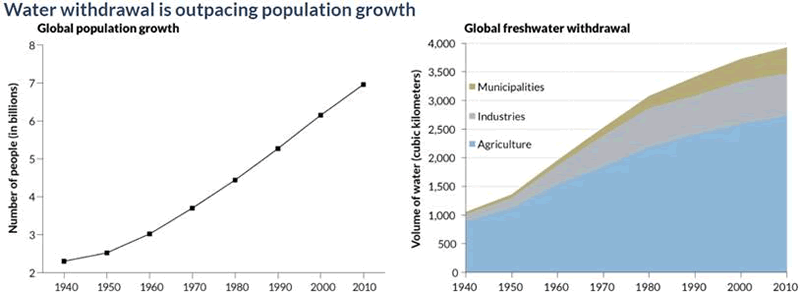
Billionsof people rely on it for survival. Yet the world’s aquifers are rapidlydepleting. We could be 40% short of water in just 12 years. And the demand forwater keeps rising. How are we going to meet it? Our current rates of depletionare unsustainable. But if we did one thing to slow the depletion ofgroundwater, it might buy us a few more years: ban bottled water companies fromextracting it.
Itdoesn’t matter whether the company is pumping it from bone-dry California orrain-soaked BC, eventually we are going to need this groundwater when the Earth warms to the point where all the glaciers meltand once-mighty rivers are reduced to trickles. Instead we’re giving it away. What are we doing?
By Richard (Rick) Mills
If you're interested in learning more about the junior resource and bio-med sectors please come and visit us at www.aheadoftheherd.com
Site membership is free. No credit card or personal information is asked for.
Richard is host of Aheadoftheherd.com and invests in the junior resource sector.
His articles have been published on over 400 websites, including: Wall Street Journal, Market Oracle,USAToday, National Post, Stockhouse, Lewrockwell, Pinnacledigest, Uranium Miner, Beforeitsnews, SeekingAlpha, MontrealGazette, Casey Research, 24hgold, Vancouver Sun, CBSnews, SilverBearCafe, Infomine, Huffington Post, Mineweb, 321Gold, Kitco, Gold-Eagle, The Gold/Energy Reports, Calgary Herald, Resource Investor, Mining.com, Forbes, FNArena, Uraniumseek, Financial Sense, Goldseek, Dallasnews, Vantagewire, Resourceclips and the Association of Mining Analysts.
Copyright © 2018 Richard (Rick) Mills - All Rights Reserved
Legal Notice / Disclaimer: This document is not and should not be construed as an offer to sell or the solicitation of an offer to purchase or subscribe for any investment. Richard Mills has based this document on information obtained from sources he believes to be reliable but which has not been independently verified; Richard Mills makes no guarantee, representation or warranty and accepts no responsibility or liability as to its accuracy or completeness. Expressions of opinion are those of Richard Mills only and are subject to change without notice. Richard Mills assumes no warranty, liability or guarantee for the current relevance, correctness or completeness of any information provided within this Report and will not be held liable for the consequence of reliance upon any opinion or statement contained herein or any omission. Furthermore, I, Richard Mills, assume no liability for any direct or indirect loss or damage or, in particular, for lost profit, which you may incur as a result of the use and existence of the information provided within this Report.
© 2005-2018 http://www.MarketOracle.co.uk - The Market Oracle is a FREE Daily Financial Markets Analysis & Forecasting online publication.
